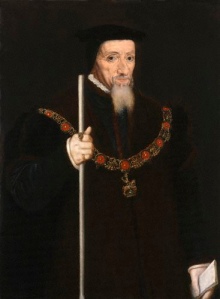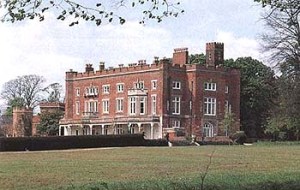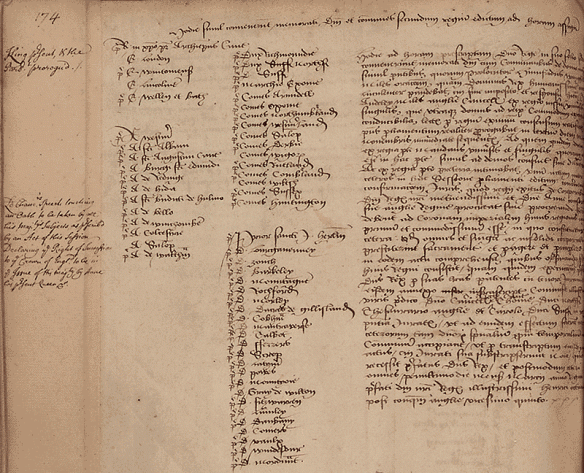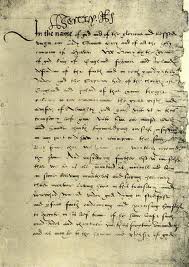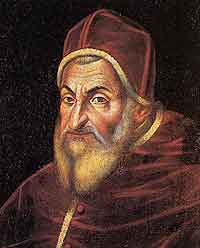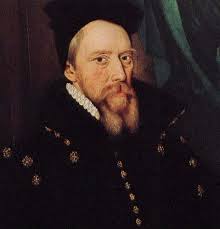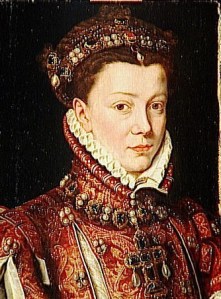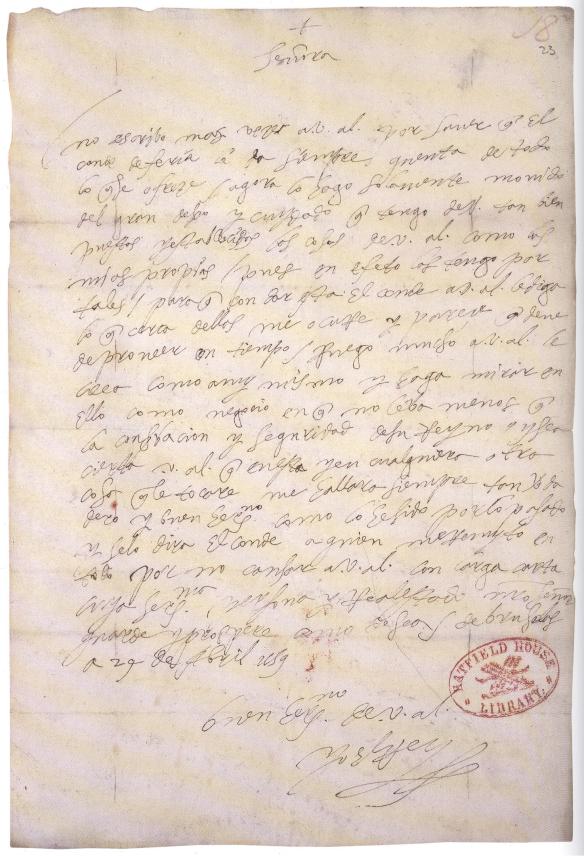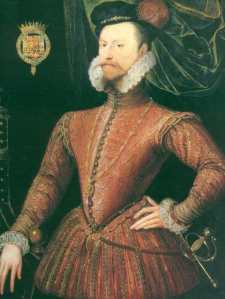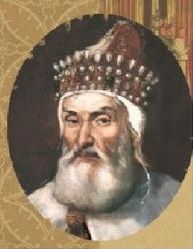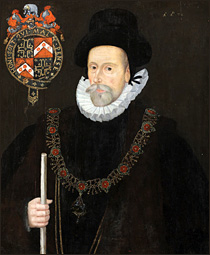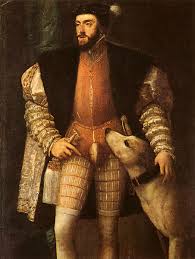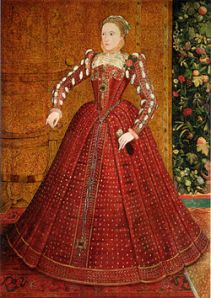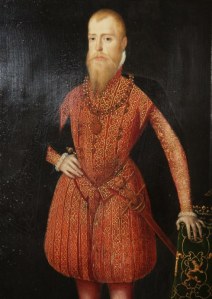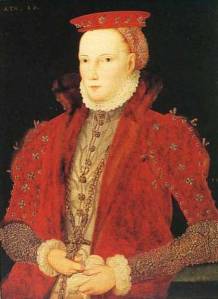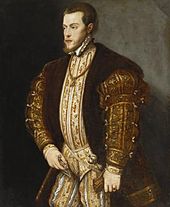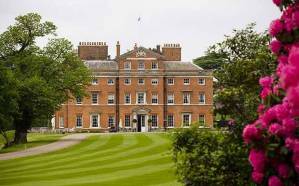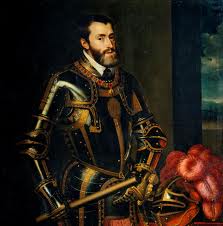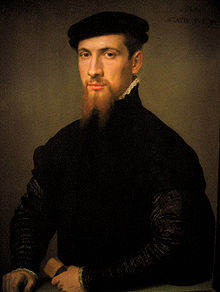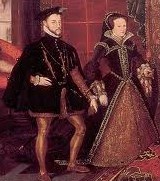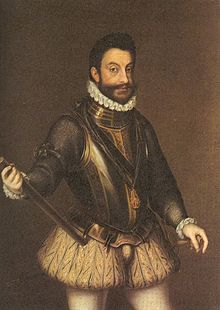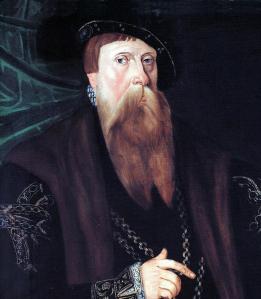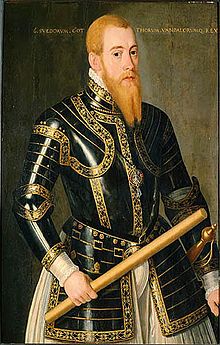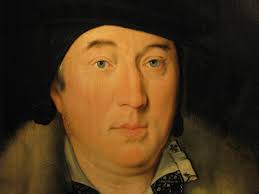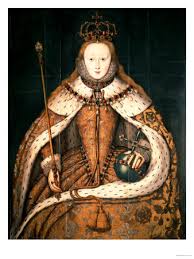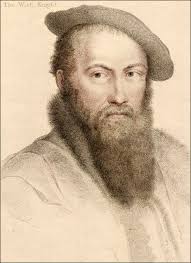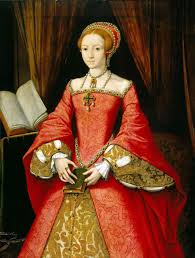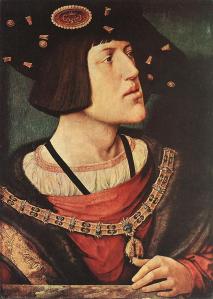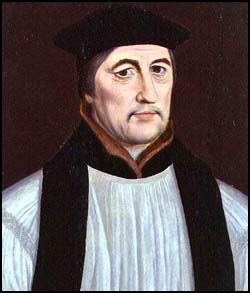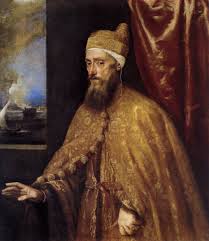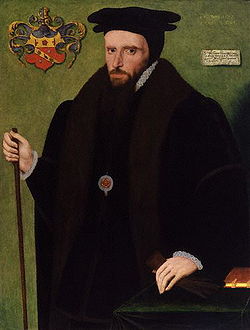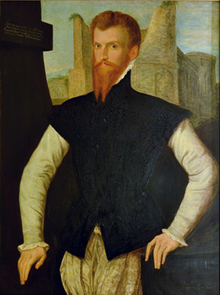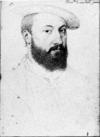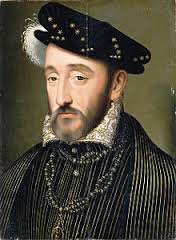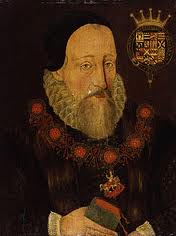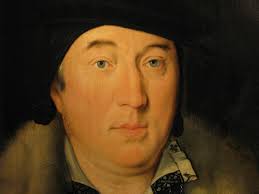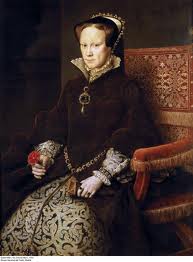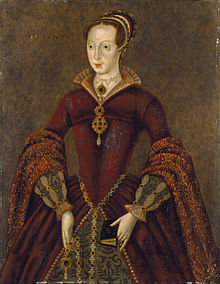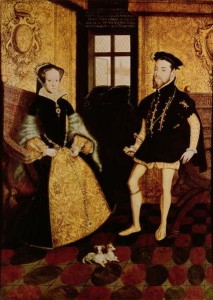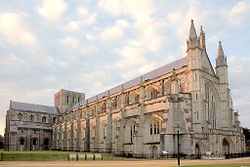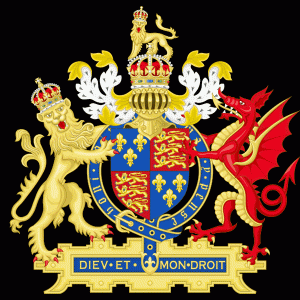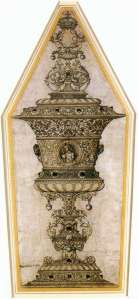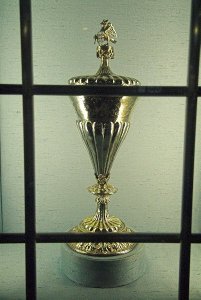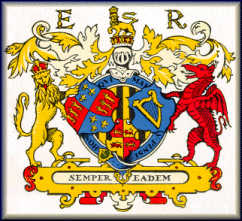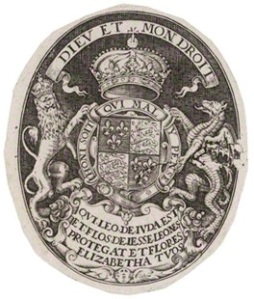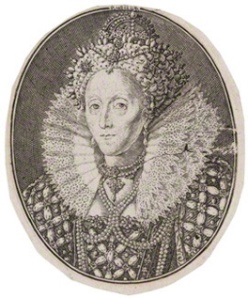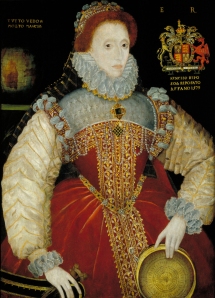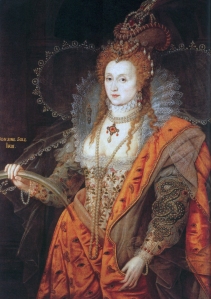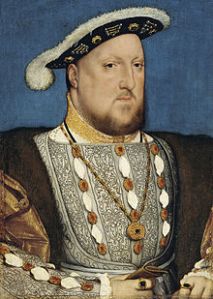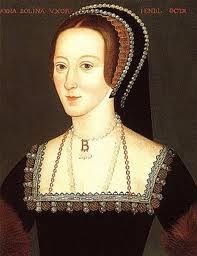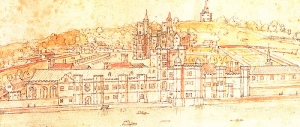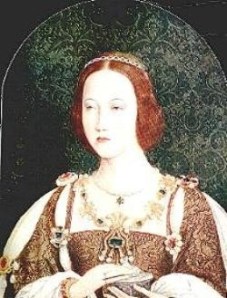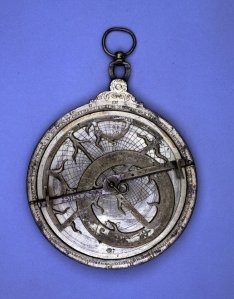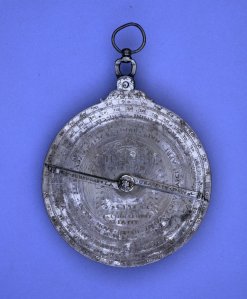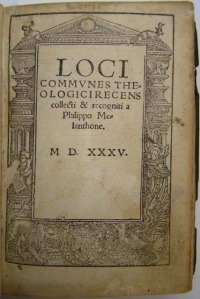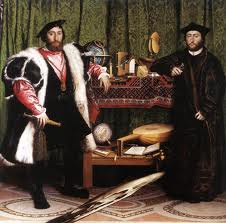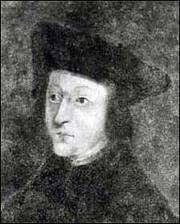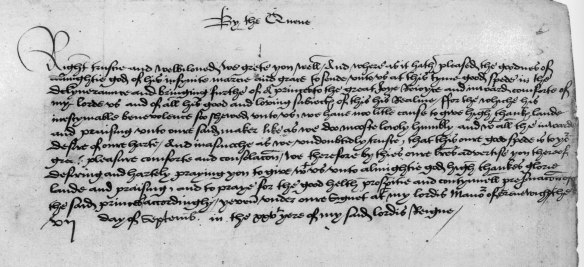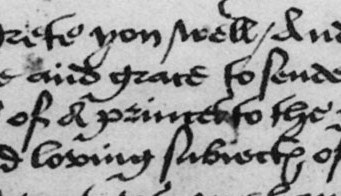Lady Bryan: An Iron Hand in a Velvet Glove
Margaret, Lady Bryan, governess to the royal children of King Henry VIII, was born about 1468 in Benningborough, Yorkshire, England. Her parents were Sir Humphrey Bourchier–who was killed fighting for Edward VI at the battle of Barnet (Wagner 180) and Elizabeth Tilney–related through the Plantagent line to Edward III. Elizabeth Tilney remarried upon the death of Sir Humphrey to Thomas Howard, 2nd Duke of Norfolk. She went on to have more children, notably the 3rd Duke who played a very prominent role in Tudor politics and Elizabeth Boleyn, mother to Queen Anne, thus making Margaret Bourchier a half-sister to Anne Boleyn’s mother.

Detail of a stained glass window at Holy Trinity Church, Long Melford, Suffolk depicting Elizabeth Tilney
The pre-contract that had been arranged with John Sands in November of 1478, did not impede her marriage to Sir Thomas Bryan in 1487. It is known the couple had four children of which, most sources agree, two reached adulthood, Sir Francis Bryan and Elizabeth.
Francis Bryan did not care for Anne Boleyn and would take a role in her downfall. He was referred to as the ‘Vicar of Hell’ by both King Henry and Thomas Cromwell for his lack of principles. He had a “reputation for liking rich clothing and for gambling. He was a popular courtier, skilled hunter and ouster, and lost an eye in a joust in 1526” (Ridgway xv). Sir Francis was a very close friend to King Henry VIII and held positions on the Privy Council until eventually he became Lord Chief Justice of Ireland where he died in 1550.
Elizabeth Bryan married Sir Nicholas Carew. The King did not forget his obligation to his loyal servants’ daughter. Accounts record a dowry, “Receipt 7 Nov. 6 Hen. VIII., from Sir John Daunce, by Dame Margaret Bryan, wife of Sir Thomas Bryan, on behalf of Mistress Elizabeth Bryan, their daughter, of 550/. Given ‘to her marriage, which by God’s grace shall be espoused and wedded to Nicholas Carewe, son and heir apparent to Sir Richard Carewe, knight, before the feast of the Purification of Our Blessed Lady the Virgin” (Brewer I 3419). Nicholas Carew was in high favor with the king and on May 3, 1516, a further wedding gift was recorded : “For NICH. CARUE. squire of the Body, son and heir of Sir Ric, and for ELIZ his wife, daughter of Tho. Bryan, vice-chamberlain to Queen Katherine. Writ to the Barons of the Exchequer, to make over lands …to the annual value of 40 mks., in part payment of 50 mrks. as a marriage portion” (Brewer II 1850).

Sir Nicholas Carew by Hans Holbein, 1533
Sir Nicholas Carew, Master of the Horse, was very close to the king. He had “at first been one of Anne’s partisans – they were cousins–but by 1532 she had alienated and angered him not only by her overbearing ways and her abuse of her position, but also by her unjust treatment of his friend, Charles Brandon, Duke of Suffolk, and his brother-in-law, Sir Henry Guildford” (Weir Lady in the Tower 33). Carew was executed in 1539 for treasonous actions. Because his assets and property were confiscated, he left his widow and children destitute. Obviously, her mother intervened and wrote from Hunsdon an imploring letter to Thomas Cromwell in 1539: “My lord, I most humbly thank your good lordship for the great goodness you shew upon my poor daughter Carew, which bindeth me to owe you my true heart and faithful service while I live. She sendeth me word that it is the king’s pleasure she shall have lands in Sussex, which is to the value of six score pounds, and somewhat above, which I heartily thank his grace and your lordship for” (Wood 112). It appears that the land did not have a house so Lady Bryan was requesting more suitable property for the widow and “her heirs males” upon which receipt it would “comfort two troubled hearts; for, my lord, unfeignedly you have, and shall have our true prayers and hearty service during our lives.” Lady Bryan wanted to assure Cromwell that she knew that putting her trust in him and the King was the best she could do for her daughter who is “so kind a child to me as she hath been, I cannot for pity do no less” (Wood 113-114).
Margaret Bryan had been a lady-in-waiting to Catherine of Aragon from the time she married Henry VIII in 1509; she also attended Catherine at her coronation and was later listed as a chamber woman (Brewer I 82). Sir Thomas was a vice chamberlain to the Queen Catherine’s household until his death sometime before 1517. Perhaps her widowhood is the reason for the king’s taking measures to assist this loyal servant. A ledger entry for November 19, 1517, was not very comforting to a servant named Elizabeth Denton, but it certainly was for Margaret Bryan. “Marg. Brian, lady mistress to the King’s daughter, the Princess states: Annuity of 40 marks for services to the Princess, during the life of Eliz. Denton, widow, who has the fee of lady mistress to the Princess, and on whose death Brian is to have her office and fee” (Brewer II 3802).
Well-placed, Lady Margaret became governess to Princess Mary and was rewarded by Henry with her own title when she was made Baroness Bryan suo jure. It is known that she stayed with Mary for almost six years and prior to being relieved of her duties was given a pension. On July 7, 1519, “Margaret Bryan, widow of Sir Thomas Bryan, and now wife of David Soche, annuity of 50/, for services to the King and queen Katharine, and one tun of Gascon wine; yearly, out of the wine received for the King’s use” (Brewer III 361). Still known as Lady Bryan, Margaret had married her final husband David Zouche sometime before July 1519.
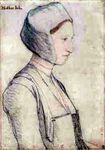
Lady Bryan, Margaret Bourchier
David Zouche is all but lost to history. Some believe he died in 1526, others in 1536 shortly after Anne Boleyn was executed. Certainly, someone important to her died in the summer of 1536 as revealed in the beginning sentence of a letter Margaret wrote to Cromwell: “I beseech you to be good lord to me now in the greatest need that ever [was], for it hath pleased God to take from me hem (them) that was my most com[fort] in this world, to my great heaviness, Jesu have mercy on his soul, a[nd] I am succourless and as a redeless creature but for my great trust in the King and your good lordship” (Gairdner XI 203).
Lady Margaret’s exact role is not clear after she left Princess Mary. Some speculate that she looked after Henry Fitzroy, the king’s illegitimate son. She was granted a gift of plate in 1532 even though the Royal household may not have directly employed her at that time (Gairdner V 1711). When she was called upon to care for Elizabeth, Lady Bryan was over the age of 60. Margaret took charge of Elizabeth at her birth and went on to setup her household at Hatfield three months later. On 2 December 1533, “The king’s highness hath appointed that the lady princess Elizabeth (almost three months old) shall be taken from hence towards Hatfield to remain with such household as the king’s highness has established for the same” (Strickland VI 6). At Hatfield and Hunsdon is where the princess “spent much of her childhood although, like her parents, she traveled from house to house, staying in such places as Richmond, Eltham, Langley,and the More” (Warnicke 170).
Much of what we know from the childhoods of Elizabeth and Edward come from the correspondence from Lady Bryan to Thomas Cromwell concerning the households of the children. In a much quoted letter to Thomas Cromwell soon after Anne’s execution, Lady Bryan lays forth the difficulties of the child’s household with her change of status, her lack of clothing and her method of eating, all to be discussed further.
Held in such esteem by King Henry VIII when his treasured male heir was born in October of 1537, Lady Bryan was installed as his governess and Kat Ashley nee Champernowne took charge as Elizabeth’s. As conscientious with the Prince as she was with Elizabeth, Lady Bryan wrote to Cromwell appraising him of her charge. A letter survives from 11 March 1539 in which young Edward is praised and touted; “Pleaseth your lordship to understand that, blessed be Jesu, my lord prince’s grace is in good health and merry, as would to God the king’s grace and your lordship had seen him yesternight; for his grace was marvelous pleasantly disposed. The minstrels played, and his grace danced and played so wantonly that he could not stand still, and was as full of pretty toys as ever I saw a child in my life; as Master Chamberlain and my lady his wife can shew your lordship when they speak with you, whom I assure your lordship giveth as good and diligent attendance as is possible” (Wood 112).
It is unclear if Margaret relinquished her duties prior to Edward’s becoming king. She was not forgotten as there is a mention of an annuity to her in January 1545. A ledger entry reads for “Lady Margaret Bryane, the King’s servant. Annuity of 20/ from the Annunciation of Our Lady last. Greenwich, 16 Jan. 36 Hen. VIII” (Gairdner XX 125). Once Edward succeeded to the throne, Lady Bryan maintained her title, but lived away from court at her estates in Essex, “where she enjoyed a generous annuity of £70 per year” (Wagner 180).

Prince Edward by Hans Holbein, 1538
We do know Lady Bryan died in Leyton, a village in Essex; the year is a bit more elusive. Various sources list her possible years of death as 1551, 1552, and 1554. One source confidently declared that Margaret “died in 1552, shortly before the proving of her will on 21 June” (Wagner 180).
When Anne Boleyn gave birth to Elizabeth in 1533, Margaret transferred her duties to become the governess of the newest royal baby. Margaret held this post until Edward was born in 1537 when she moved to his household and Katherine Ashley took over duties with Princess Elizabeth. Anne did not have much say in her child’s upbringing—that was for Henry and his council. When Lady Bryan thought Elizabeth should be weaned, she contacted Lord Cromwell and then he submitted the request to the Privy Council.
A response from Sir William Paulet, onetime Comptroller of the Royal Household and Lord Chamberlain to Henry VIII, to Thomas Cromwell on 9 October 1535 addressed the issue of Elizabeth’s weaning. “The King having considered the letter to Cromwell from lady Brian and other of the Princess’s officers, has determined that she shall be weaned with all diligence” (Gairdner IX 568). Agnes Strickland gives us some sardonic imagery when she tells us that in order for Elizabeth to be weaned “the preliminaries for this important business were arranged between the officers of her household and the cabinet ministers of her august sire, with as much solemnity as if the fate of empires had been involved in the matter” (Strickland Life of Elizabeth 6).
Having the charge of the royal children meant teaching them etiquette and proper manners—and displaying the children in the majesty expected. “Lady Bryan, who had brought Mary up until she was six, had been accustomed to treat her as the heiress to the throne for seventeen years. She must have been profoundly embarrassed when the girl was sent to share Elizabeth’s household with orders to ride behind the baby’s litter on progress and to cede the seat of honour even when the infant was still in the care of a wet-nurse” (Perry 19). But as a stickler to her duty, it can be assumed she ensured the King’s wishes were fulfilled.
Chapuys, no friend of Elizabeth, shared with Charles V a meeting that took place on the Tuesday following Easter of 1534 between the French Ambassadors, La Pommeraye and Catillion and Elizabeth. This visit was orchestrated to present Elizabeth as a fitting bride for a French prince and full-credit for its success went to Lady Bryan. The Ambassadors “went to visit the King’s bastard daughter, who was brought out to them splendidly accoutred and dressed, and in princely state, with all the ceremonial her governess could think of” (Gayangos V 40).
That Lady Bryan took this portion of her duties seriously was again shown in her letter to Cromwell. It is speculated this letter was written in response to Lord Chancellor Thomas Audeley’s proposed visit to baby Prince Edward in 1537. Lady Bryan wrote:
“My lord,
After my most bounden duty I humbly recommend me unto your good lordship; and shall accomplish it to the best of my power…. The best coat my lord prince’s grace hath is tinsel, and that he shall have on at that time; he hath never a good jewel to set on his cap; howbeit I shall order all things for my lord’s honour the best I can, so as I trust the king’s grace shall be contented withal” (Wood 68-69).
Her affection seemed sincere for her royal charges and her pride in them too. She could not help but brag on Prince Edward, informing Cromwell, “I thank Jesu my lord prince’s grace is in good health and merry, and his grace hath four teeth; three full out, and the fourth appeareth” (Wood 69).
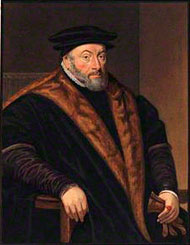
Lord Chancellor, Thomas Audeley
“Much of the future greatness of Elizabeth may reasonably be attributed to the judicious training of her sensible and conscientious governess, combined with the salutary adversity, which deprived her of the pernicious pomp and luxury that had surrounded her cradle while she was treated as heiress of England” (Strickland VI 12). Elizabeth was brought up calmly in the way that Lady Bryan thought best, shielded from the gossip and temptations of the adult world. Lady Bryan no doubt shielded Princess Elizabeth as much as she could from the gossip surrounding her mother and the inevitable slander that began shortly after Anne’s death concerning the paternity of her daughter (Weir, The Lady in the Tower 316-317).
The king’s order for Elizabeth to remain in seclusion could have been his attempt to protect her as much as the theory that it was his unwillingness to face the child. To read further on this topic visit the blog entry “Elizabeth: Her Mother’s Memory” @elizregina.com. This blogger believes that Agnes Strickland judged the Tudor Era with the mores of her own time period when she exclaimed that when “Elizabeth was branded with the stigma of illegitimacy; she was for a time exposed to the sort of neglect and contempt which is too often the lot of children to whom that reproach applies” (Strickland VI 9). Henry VIII did not neglect his recognized illegitimate son, Henry FitzRoy, and perhaps he did not purposefully neglect Elizabeth in the summer of 1536. He was embarking on a new life with his third wife, Jane Seymour, and was traveling the country. We have seen how the final word of the organization of the children’s households rested with Henry. His thoughts were on her to some degree so it could not be his indifference that led to the ‘crisis’ of her wardrobe and her household but perhaps more of benign neglect—administrative oversight. That her position was diminished was obvious. “On 25 June 1536, an order reconstituted the households of Mary and Elizabeth. It was certainly no coincidence, in that age when the number of servants in a household was a great status symbol, that Mary was given fourty-two servants, and Elizabeth thirty-two” (Ridley 26). Below reprinted in chart form is the information from the 10th volume of Letters and Papers of Henry VIII concerning the structural changes made to the two households.
| Personages appointed to attend on the lady Mary:— Gentlewomen. Anne Morgan, Mrs. Finche, Frances Jerningham, Elizabeth Sydney. Chamberers: Systile (Cecil ?) Barnes, Lucretia the Tumbler. Gentlemen Ushers and Waiters: Richard Wilbraham, Robt. Chichester, Sir Ric. Baldwin, Walter Bridges, Thos. Burrows. Wardrobe of Robes: Thos. Palmer, Nic. Newes. Footman: Chas. Morley. Laundress: Deachryche (Beatrice) Ap Rice. Woodbearer: John Layton. Keeper of Greyhounds: Christopher Bradley. The Stable: Thos. Jene, yeoman; Ric. Hogg, Nic. Twydall, and Thos. Crabtree, grooms. |
| The names of persons attending upon lady Mary and lady Elizabeth:— i. On lady Mary:— Gentlewomen: Susan Clarencyus, Frances Elmer, Mary Baynton Frances Baynan. “Chamberes:” Knyght, Syssele. Physician: Dr. Mychell. Gentlemen: Ant. Cotton, Wm. Chechester, Ric. Wylbram, Randale Dod, Sym Borton. Chaplain: Bauldewen. Yeoman: Geo. Mounge, David à Pryce, Chr. Wryght, John Conwey, Gray. Grooms of the Chamber: Thos. Borow, Walter Brydges, Thos. Palmer, Nic. Newes. Footman: Chas. Morley. Stable: Thos. Gent, yeoman; Thos. Bell, John Smith, and John Hyges, grooms. Laundress: Beatrice a Pryce. Woodbearer: William. Total, 42. |
| On lady Elizabeth:— Ladies and gentlewomen: Lady Troy, Mrs. Chambrum, lady Garet, Eliz. Candysche, Mary Norice. “Chamberes:” Alys Huntercum, Jane Bradbelt. Gentlemen: Thos. Torrell, Robt. Porter, Ric. Sandes.Chaplain: Sir Rauffe. Grooms of the Chamber: Ric. Foster, Wm. Russell. Yeomen: David Morgan, Gabryell Tenant. Laundress: Agnes Hylton. Woodbearer: Christopher. Total, 32. |
| Personages appointed to attend on the lady Elizabethe, the Kinges doughter.” Gentlewomen: Kateryne Chambernowne, Elizabethe Garret, Mary Hyll, Blanche ap Harrye. Chamberers: Alice Huntercombe, Jane Bradbelt. Gentlemen Ushers and Gentlemen Waiters: Rychard Sandes, Robert Power. Chaplain: Sr Raffe Taylour. Gromes of the Chambre: Willm. Man, John Acton. Wardrobe of Robes: John Goughe, yeoman. Lawndresse: Anne Hilton. Woodberer: John Wyllycke |
| (Gairdner X 1187) |
Lady Bryan’s letter to Thomas Cromwell in the summer of 1536, which was referred to earlier and has been recreated in full below, can be seen as a way to restore the prestige of and attention on Elizabeth’s household which was at Hunsdon. Cromwell’s response has not survived but Mistress Bryan’s concerns must have been addressed as there appears to be no further pleas on her part. Her initial issue involved the altered status Elizabeth held. Lady Bryan was searching for guidance when she wrote, “Now, as my lady Elizabeth is put from that degree she was in, and what degree she is at now I know not but by hearsay, I know not how to order her or myself, or her women or grooms” (Gairdner XI 203).
Next up was the issue of Elizabeth’s wardrobe. It was up to “the lady mistress to make certain Elizabeth looked and acted like a king’s daughter, and proper clothes were essential to the role” (Erickson 37). Margaret was beside herself as she begged Cromwell “to be good lord to her and hers, and that she may have raiment, for she has neither gown nor kirtle nor petticoat, nor linen foresmocks, nor kerchiefs, rails (night dresses), bodystychets (corsets), handkerchiefs, sleeves, mufflers, nor begins (night-caps). All thys her Graces must take I have dreven off as long as I can, that, be my trothe, I cannot drive it no lenger. Besseeching you, my lord, that ye will see that her grace may have that which is needful for her, as my trust is that ye will do” (Gairdner XI 203).
The condition of Elizabeth’s wardrobe “reflected the general penury of the household” (Erickson 38). Money must have been tight as the final concern that Lady Bryan has mixes the role of the steward, John Shelton, with the need for economy. Shelton, who was responsible for keeping up the supplies of food, drink and other items necessary for the household, wrote to Cromwell shortly after Lady Bryan did to complain that he was “running short of money and ‘could not continue’ without more.” This may not have been easy to acquire as the king’s Secretary Brian Tuke “had made it clear only a week earlier that he hoped Mr. Shelton would not be appealing for additional funds, as he had little or nothing to give him” (Erickson 38).
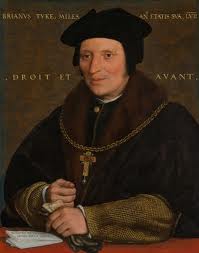
Sir Brian Tuke by Hans Holbein, 1527
Lady Bryan’s tactic was to explain the poor judgment on Shelton’s part– who, she lets us know, “saith he is master of this house. ‘What fashion that shal be I cannot tel, for I have not seen it afore.’” (Gairdner XI 203)–and offer a solution. Apparently, Shelton “would have my lady Elizabeth to dine and sup every day at the board of estate.” Margaret explains that this is not good for a child and “she will see divers meats, fruits, and wine, that it will be hard for me to refrain her from. ‘Ye know, my lord, there is no place of correction there; and she is too young to correct greatly.’ I beg she may have a good mess of meat to her own lodging, with a good dish or two” which would be enough to feed 11 of her personal attendants which in turn would be more economical as less people would have to be fed in the great hall (Gairdner XI 203).
One theory for Mr. Shelton, a relative of Anne Boleyn, actions could be that he “wished to keep regal state as long as possible round the descendant of the Boleyns” and with “perhaps an eye to ingratiate himself with the infant, by indulging her by the gratification of her palate with mischievous dainties” (Strickland VI 11). Or, as this blogger wonders, could it be a way for him and his associates to be served elaborate meals at the King’s expense.
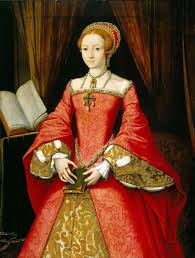
Princess Elizabeth
This letter, which gives us a peek into the politics of the household, ends with Margaret expressing sympathy for Elizabeth’s teething. The governess realizes that witnessing the pain the child is in, “makes me give her her own way more than I would” yet excuses herself by assuring Cromwell that “she is as toward a child and as gentle of conditions as ever I knew any in my life….” Determined in her duties, Lady Bryan wanted to ensure that when the time came for Elizabeth to be “set abroad, I trust so to endeavour me that she shall so do as shall be to the King’s honour and hers…”(Gairdner XI 203).
Letter from Lady Margaret Bryan to Thomas Cromwell, June 1536
I beseech you to be good lord to me now in the greatest need that ever [was], for it hath pleased God to take from me hem (them) that was my most com[fort] in this world, to my great heaviness, Jesu have mercy on his soul, a[nd] I am succourless and as a redeless creature but for my great trust in the King and your good lordship. When your lordship was last here you bade me not mistrust the King or you, which gave me great comfort, and encourages me now to show you my poor mind. When my lady Mary was born the King appointed me lady Mistress, and made me a baroness; ‘And so I have been a governess to the children his Grace have had since.’
Now, as my lady Elizabeth is put from that degree she was in, and what degree she is at now I know not but by hearsay, I know not how to order her or myself, or her women or grooms. I beg you to be good lord to her and hers, and that she may have raiment, for she has neither gown nor kirtle nor petticoat, nor linen foresmocks, nor kerchiefs, rails (night dresses), bodystychets (corsets), handkerchiefs, sleeves, mufflers, nor begins (night-caps). All thys her Graces must take I have dreven off as long as I can, that, be my trothe, I cannot drive it no lenger. Besseeching you, my lord, that ye will see that her grace may have that which is needful for her, as my trust is that ye will do. Beseeching ye, mine own good lord, that I may know from you, by writing, how I shall order myself, and what is the king’s grace’s pleasure and yours; and that I shall do in everything? And whatsomever it shall please the king’s grace or your lordship to command me at all time, I shall fulfil it to the best of my power.
Mr. Shelton saith he is master of this house. ‘What fashion that shal be I cannot tel, for I have not seen it afore.’ I trust to your lordship, who, as every man reports, loveth honour, to see this house honourably ordered,’ howsom ever it hath been aforetime.’ If the head of [the same] know what honor meaneth it will be the better ordered; if not, it will be hard to bring it to pass.
Mr. Shelton would have my lady Elizabeth to dine and sup every day at the board of estate. It is not meet for a child of her age to keep such rule. If she do, I dare not take it upon me to keep her Grace in health; for she will see divers meats, fruits, and wine, that it will be hard for me to refrain her from. ‘Ye know, my lord, there is no place of correction there; and she is too young to correct greatly.’ I know well and she be there, I shall neither bring her up t the king’s grace’s honour, nor hers, nor to her health, nor to my poor honesty.
I beg she may have a good mess of meat to her own lodging, with a good dish or two meet for her to eat of; and the reversion of the mess shall satisfy her women, a gentleman usher, and a groom; ‘which been eleven persons on her side.’ This will also be more economical.
God knoweth my lady hath great pain with her teeth, which come very slowly. This makes me give her her own way more than I would. ‘I trust to God and her teeth were well graft to have her Grace after another fashion than she is yet; so, as I trust, the King’s Grace shall have great comfort in her Grace. For she is as toward a child and as gentle of conditions as ever I knew any in my life, Jesu preserve her Grace. As for a day or two at a hey time or whansomever it shall please the King’s Grace to have her set abroad, I trust so to endeavour me that she shall so do as shall be to the King’s honour and hers; and then after to take her ease again. I think Mr. Shelton will not be content with this. He may not know it is my desire, but that it is the King’s pleasure and yours it should be so.’ From Hunsdon with the evil hand of your daily bede woman.
Apologies for her boldness in writing thus” (Gairdner XI 203).
References
Brewer, J. S. (editor). “Henry VIII: November 1514, 2-10.” Letters and Papers, Foreign and Domestic, Henry VIII, Volume 1: 1509-1514 (1920): 1431-1444. British History Online. Web. 06 July 2013.
Brewer, J. S. (editor). “Henry VIII: November 1517.” Letters and Papers, Foreign and Domestic, Henry VIII, Volume 2: 1515-1518 (1864): 1183-1198. British History Online. Web. 29 June 2013.
Brewer, J. S. (editor). “Henry VIII: July 1519, 1-15.” Letters and Papers, Foreign and Domestic, Henry VIII, Volume 3: 1519-1523 (1867): 121-136. British History Online. Web. 30 June 2013.
Erickson, Carolly. The First Elizabeth. New York: Summit Books. 1983. Print.
Gairdner, James. (editor). “Henry VIII: April 1534, 16-20.” Letters and Papers, Foreign and Domestic, Henry VIII, Volume 7: 1534 (1883): 199-210. British History Online. Web. 29 June 2013.
Gairdner, James (editor). “Henry VIII: February 1535, 11-20.” Letters and Papers, Foreign and Domestic, Henry VIII, Volume 8: January-July 1535 (1885): 75-98. British History Online. Web. 29 June 2013.
Gairdner, James (editor). “Henry VIII: October 1535, 6-10.” Letters and Papers, Foreign and Domestic, Henry VIII, Volume 9: August-December 1535 (1886): 181-195. British History Online. Web. 29 June 2013.
Gairdner, James (editor). “Henry VIII: Miscellaneous, 1536.” Letters and Papers, Foreign and Domestic, Henry VIII, Volume 10: January-June 1536 (1887): 531-537. British History Online. Web. 06 July 2013.
Gairdner, James (editor). “Henry VIII: August 1536, 16-20.” Letters and Papers, Foreign and Domestic, Henry VIII, Volume 11: July-December 1536 (1888): 130-138. British History Online. Web. 28 June 2013.
Gairdner, James (editor). “Henry VIII: June 1538, 26-30.” Letters and Papers, Foreign and Domestic, Henry VIII, Volume 13 Part 1: January-July 1538 (1892): 464-491. British History Online. Web. 06 July 2013. <
Gairdner, James and R. H. Brodie (editors). “Appendix.” Letters and Papers, Foreign and Domestic, Henry VIII, Volume 14 Part 2: August-December 1539 (1895): 359-372. British History Online. Web. 06 July 2013.
Gairdner, James and R. H. Brodie (editors). “Henry VIII: January 1545, 26-31.” Letters and Papers, Foreign and Domestic, Henry VIII, Volume 20 Part 1: January-July 1545 (1905): 38-59. British History Online. Web. 30 June 2013.
Gayangos, de Pascual (editor). “Spain: April 1534, 11-20.” Calendar of State Papers, Spain, Volume 5 Part 1: 1534-1535 (1886): 110-124. British History Online. Web. 07 July 2013.
Gristwood, Sarah. Elizabeth & Leicester: Power, Passion, Politics. New York: Viking, 2007. Print.
Hibbert, Christopher. The Virgin Queen: Elizabeth I, Genius of the Golden Age. New York: Addison-Wesley Publishing Company, Inc., 1991. Print.
Ives, Eric. The Life and Death of Anne Boleyn: The Most Happy. Oxford: Blackwell Publishing, 2004. Print.
Neale, J. E. Queen Elizabeth I. Garden City, NY: Doubleday, 1957. Print.
Perry, Maria. The Word of a Prince: A Life of Elizabeth from Contemporary Documents. Woodbridge, Suffolk: The Boydell Press, 1990. Print.
Ridgway, Claire. The Fall of Anne Boleyn: A Countdown. UK: MadeGlobal Publishing, 2012. Print.
Ridley, Jasper. Elizabeth I: The Shrewdness of Virtue. New York: Fromm International Publishing Corporation, 1989. Print.
Sander, Nicholas, and Edward Rishton. Rise and Growth of the Anglican Schism. Trans. David Lewis. London: Burns & Oates, 1877. Google Books. Web. 28 June 2013.
Somerset, Anne. Elizabeth I. New York: Alfred A. Knopf, 1991. Print.
Starkey, David. Elizabeth: The Struggle for the Throne. New York: HarperCollins Publishers. 2001. Print
Strickland, Agnes. The Life of Queen Elizabeth. London: J.M. Dent &, 1906. Google Books. Web. 3 June 2013.
Strickland, Agnes, Elisabeth Strickland, and Rosalie Kaufman. The Queens of England, Vol VI. Chicago: Werner, 1895. Internet Archive. Web. 4 May 2013.
Wagner, John and Susan Walters Schmid. Encyclopedia of Tudor England. Santa Barbara, California: ABC-CLIO, 2012. Google Books. Web 29 June 2013.
Warnicke, Retha. The Rise and Fall of Anne Boleyn: Family Politics at the Court of Henry VIII. Cambridge: Cambridge University Press, 1989. Print.
Weir, Alison. The Children of Henry VIII. New York: Ballantine Books, 1996. Print
Weir, Alison. Henry VIII: The King and His Court. New York: Ballatine Books, 2001. Google Books. Web. 30 June 2013.
Weir, Alison. The Lady in the Tower: The Fall of Anne Boleyn. London: Jonathan Cape, 2009. Print.
Wood, Mary Anne Everett. Letters of Royal and Illustrious Ladies of Great Britain: From the Commencement of the Twelfth Century to the Close of the Reign of Queen Mary : Edited, Chiefly from the Originals in the State Paper Office, the Tower of London, the British Museum and Other State Archives. Vol. III. London: Henry. Colburn, 1846. Google Books. Web. 5 July 2013.
POST THIS ONE AFTER THE ELIZATH AND HER MOTHER SINCE NEED TO GET THE BLOG ADDRESS TO ADD IN HERE



